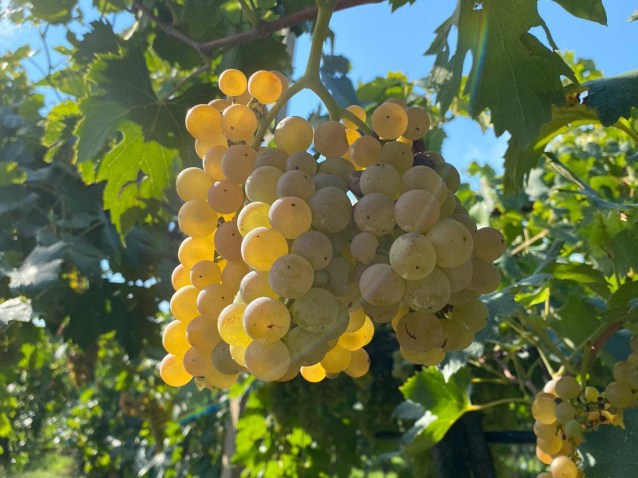 Above: a Garganega cluster. Photo courtesy of Soave producer Anselmi, one of my favorite Garganega growers and winemakers (thank you, Lisa!).
Above: a Garganega cluster. Photo courtesy of Soave producer Anselmi, one of my favorite Garganega growers and winemakers (thank you, Lisa!).
Last Wednesday, a guest at a private virtual tasting pressed me about the origins of the grape name Garganega (we were tasting a famous Soave producer together via Zoom). It wasn’t the time or place to go into extreme detail (the occasion was a birthday party and the setting was the host’s dining room). But I wanted to follow up here on the blog this week because even though the ampelonym’s etymology is still unknown, it leads us down a philologic trail that is as compelling as it is revealing.
There are two main although unproven theories as to its fons et origo.
Some Italian philologists posit that it may be a dialectal inflection of garganico meaning from/of Gargano (pronounced Gargàno), a sub-region of Foggia province in Puglia.
In my view, this is the more tenable thesis. In antiquity, grape names were often derived from toponyms (e.g., Prosecco and Nero d’Avola among many others). This was probably owed to how the wines made from those grapes were sold or shipped. And Veneto’s historic link to Puglia as its last port of call may have had an influence.
On the other hand, Italian ampelographers (who often cite only secondary sources and frequently offer unfounded philological speculation) surmise that it comes from or is related to the grape name Grecanico because of its genetic relation to the grape Grecanico Dorato, a variety cultivated in Sicily.
The botanists (because that’s what ampelographers are) claim that the ancients believed grapes like Greco, Grecanico, Grechetto came from Greece. And so, the theory goes, they named them accordingly. In fact, the word greco referred to a winemaking style (and not an ampelonymic classification) in the Middle Ages. Medieval Italians — and especially the Venetians and Neapolitans — held Greek viticulture in high esteem and so it was only natural for them to lend the name greco to their most prized grape varieties.
The bottomline is that we still don’t know where the grape name came from and both theories are inconclusive and without any hard documentation.
The earliest known mention of Garganega (and here’s where it gets really interesting, the whole point of philology) is found in the Ruralium Commodorum by Pietro de’ Crescenzi, the prolific 14th-century jurist and botanist.
Many ampelographers cite Crescenzi but none, at least that I can find, have actually read his work.
The wine made from Garganega, wrote Crescenzi in the first decade of the 1300s, “is fine and brightly colored, with low alcohol, and is highly age-worthy. Many praise it in Padua and Bologna. But some scorn it because it is favored with great importunity by the worst kind of thieves.”
It’s important to note that he doesn’t refer to Padua and Bologna as viticultural centers (as some ampelographers erroneously claim). In fact, he mentions those two cities because at the time, they were two of northern Italy’s most important cultural and commercial hubs. Both cities were already home to what are now considered the oldest universities in the western world.
 Crescenzi’s notes on Garganega would later be cited by the editors of the Accademia della Crusca’s 17th-century dictionary. In their entry for femmina (above), they quote his description of the grape as an example of a description of a female plant or flower.
Crescenzi’s notes on Garganega would later be cited by the editors of the Accademia della Crusca’s 17th-century dictionary. In their entry for femmina (above), they quote his description of the grape as an example of a description of a female plant or flower.
“And another type of grape is called Garganega… The female [Garganega] produces a lot of fruit. The male is worthless,” they write quoting Crescenzi.
The fact that the Crusca uses this passage from Crescenzi is an indication of how popular Garganega wines were in antiquity.
Even the ampelographers would agree on this point. And so would the thieves.
